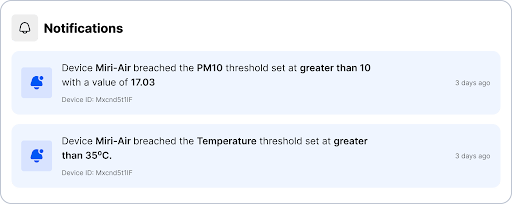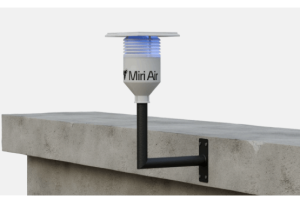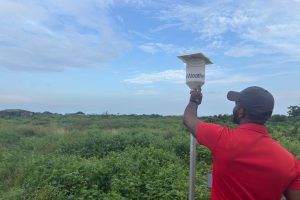My teammates and I were having a huddle about the importance of what we are building at Climate in Africa when Obinna, our Brand and UI Designer, asked a question that struck at the heart of our mission:
“What happens after Miri Air has tracked the pollution?”
This question shifts the focus from the technology to impact. What good is data if it doesn’t change lives? To answer it, we need to revisit why we built Miri Air and why air quality monitoring is critical across Africa.
Why Measure Air Quality?
1. Making the Invisible Visible
Air pollution is often invisible, yet its effects are everywhere. Measurement allows us to see what is otherwise hidden, making pollutants visible, quantifying their concentration, and identifying hotspots. It answers three fundamental questions:
- What pollutants are in our air
- How much is present?
- Where are the pollution hotspots?
2. A Lifeline for Africa
For Africa, a continent experiencing rapid urbanization, industrialization, and population growth, air quality measurement is not just important; it is a lifeline. Air pollution is already linked to a growing public health crisis, yet the data needed to track it is scarce and fragmented.
3. Informing Action and Saving Lives
Reliable air quality data is the engine for change. It empowers policymakers, researchers, communities, and businesses to make informed decisions that protect health and improve quality of life.
Imagine a patient visiting a doctor. The first step is always diagnosis. The doctor needs to understand the problem before prescribing treatment. Air quality data is that diagnosis for our environment. It tells us what is wrong, where the problem is, and what needs to be fixed. The real impact comes after the measurement.
We explored this in detail in our earlier blog, The urgent need for air quality measurement in Africa.

Now that we have briefly talked about the importance of air quality measurement, let’s return to Obinna’s question; “What happens after Miri Air has tracked the pollution?”
The data tracked data is used for;
1. Researchers: Building the Scientific Backbone
Air quality data is the raw material for science. Researchers use it to identify sources and patterns, analyzing long-term trends to separate contributions from vehicles, industries, biomass burning, and natural dust. This data underpins epidemiological studies that link exposure to pollutants like PM₂.₅ with asthma, cardiovascular disease, and premature mortality. It also allows scientists to model scenarios, predicting how new policies (like cleaner transport systems) or broader climate changes will affect future air quality. Without data, none of this science is possible.
2. Early Warning and Disaster Preparedness: A Personal Safety Net
Air quality data provides a foundation for early warning and preparedness. Instead of reacting only after exposure, individuals and institutions can anticipate risks and act ahead of time.

Imagine receiving an alert from your Miri Air device that PM₂.₅ levels are dangerously high. That single notification could trigger a life-saving habit; putting on a nose mask before stepping outside.
This principle is reflected in the Yoruba adage: “Ògún á sọ̀ tèlè, kì ín pa àrò tó bá gbón,” meaning “a war announced well in advance never kills the smart lame.” The proverb accentuates the scientific value of early signals: foreknowledge allows even the most vulnerable to prepare and survive.
3. Evidence-Based Policy: Building Smarter Regulations and Cities

Air quality data reveals the true state of pollution, informing laws, evaluating policies, and guiding strategic investments. For environmental protection agencies, continuous monitoring provides the evidence needed to:
- Set enforceable standards.
- Track compliance.
- Identify pollution hotspots.
- Model exposure risks.
- Issue public health advisories.
It also shapes infrastructure planning. Like ensuring schools and hospitals are sited away from major pollution sources, or prioritizing green investments in the worst-affected communities. With robust data, cities can grow smarter, not just larger.
4. Law Enforcement: Ensuring Accountability and Compliance

Data transforms enforcement from guesswork into evidence-based action.
- Targeted inspections: Regulators can focus on facilities that consistently exceed limits.
- Proof of violations: Continuous monitoring provides irrefutable evidence for fines, clean-ups, or shutdowns.
- Monitoring compliance: Data verifies whether corrective actions taken after enforcement are effective.
This approach is already being applied in Lagos State, where the Lagos State Environmental Protection Agency (LASEPA) has partnered with Climate in Africa through the Miri Air platform. Equipped with real-time, high-precision air quality data, LASEPA has strengthened its enforcement capacity. In a recent intervention, the agency shut down 33 facilities operating outside environmental compliance standards, demonstrating how monitoring data directly enables accountability, protects public health, and reinforces regulatory authority.

5. Funding: Making the Invisible Crisis Visible

Ultimately, robust data is crucial to unlocking the resources necessary to address the problem. According to the Clean Air Fund’s 2024 State of Global Air Quality Funding Report, between 2015 and 2021, only 3.7% of international development funding in Africa was directed toward air quality projects. One reason is simple: without consistent measurement, the problem remains invisible. Concrete data changes that. It demonstrates scale and urgency to funders, provides baselines to measure impact, and offers proof of return on investment. With visibility comes funding, and with funding comes the capacity to scale solutions. Without data, there is no evidence; without evidence, there is no funding.
Air quality measurement is the first step to impact.
So, what happens after Miri Air tracks pollution? The answer is impact. Data makes the invisible visible, provides a lifeline for Africa’s growing cities, empowers researchers, strengthens early warning systems, guides smarter policies, enforces accountability, and unlocks critical funding. At Climate in Africa, our mission is not only to measure but also to act to ensure that every data point becomes a step toward cleaner air, healthier people, and a more resilient continent.





